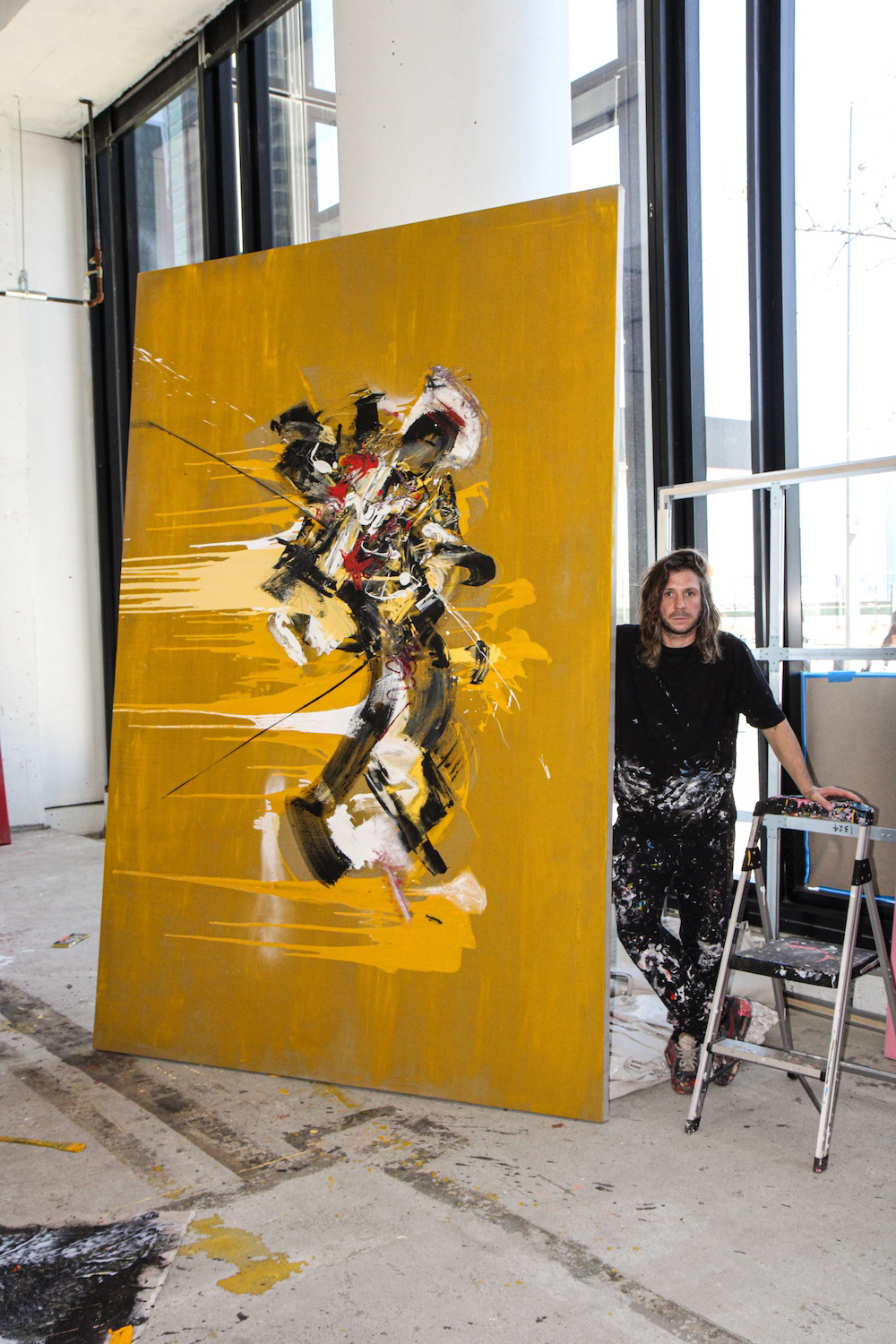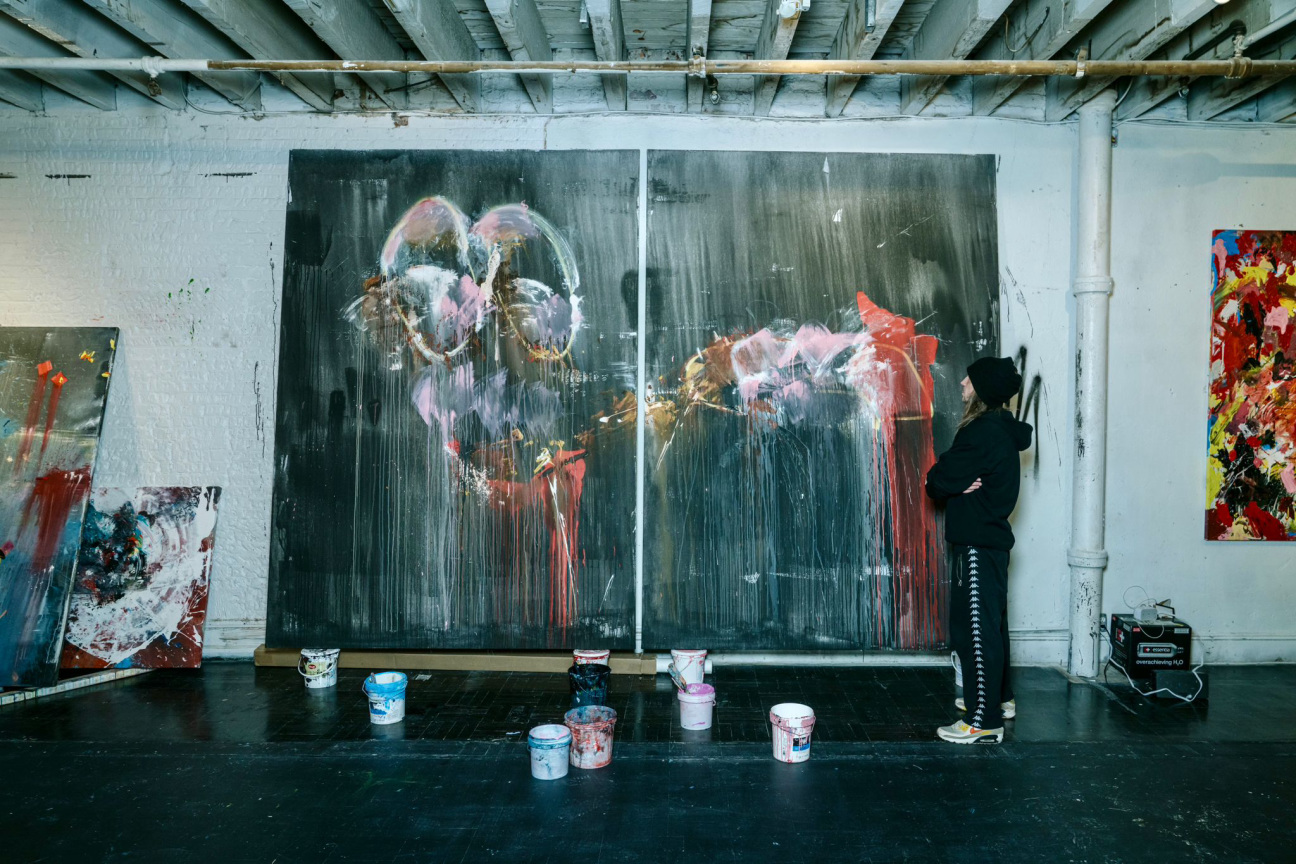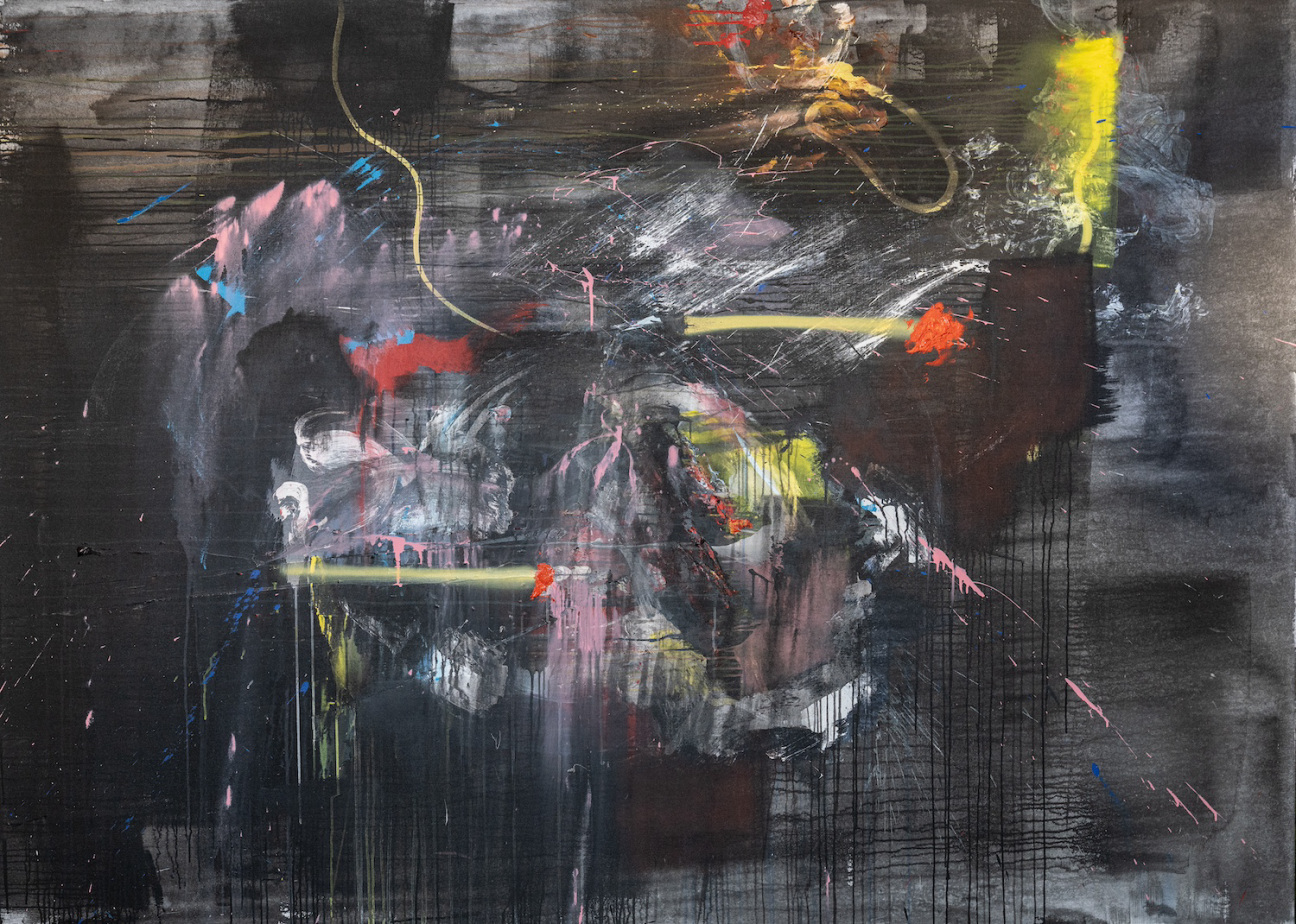
Prior to 2016, Robyn Ward was a name unknown to the art world. Not because he was absent from the scene, but because he chose to release his work—sweeping, large-scale paintings with a distinctly street attitude—under multiple pseudonyms and artist collectives. Then, he broke from tradition.
"For a long period of my life, I was really vulnerable to people criticizing my work, and when you put a painting out there, you are very much naked on a wall for people to judge," he explains. But eight years ago, "I stopped caring as much about what other people think."
Casual viewers would be hard-pressed to identify a lack of confidence in Ward's oeuvre, which has popped up in cities from Mexico City to New York alongside such boldface names as Damien Hirst, David Hockney, Marina Abramović, and Anish Kapoor. Having grown up in the North of Ireland during the tail end of the Troubles and having spent his adult life bouncing between London, New York, Bali, and elsewhere, a global, at times anarchist, perspective permeates Ward's work. Politics of the past are layered on top of current issues, drawing attention to the mistakes we failed to learn from as well as our boundless potential.
Most recently, Shanghai's Modern Art Museum showed an expanded iteration of Ward's exhibition "Walking in the Dark," and this September, he returns to London with a solo show at Gallery Rosenfeld. Here, the artist takes stock of a busy year and charts his influences, from surfing to childhood graffiti.
CULTURED: Where, if at all, do you find intersections between your practices as a surfer and as an artist?
Robyn Ward: I find the two things very difficult to compare. Surfing humbles me daily. I ponder drowning most times I paddle out, because I constantly feel out of my depth and with zero control. It’s always a stark reminder of how small you are. You are battling with nature, and the ocean is something you can never beat. Understanding the ocean and respecting it at all times is key. Surfing for me is more of an escape, keeping me focused and healthy and away from other temptations. In that sense, it helps me to focus on my art when I’m back on dry land.

CULTURED: How did you first begin your practice?
Ward: I began painting large-scale works when I was around 15 years old. I used to paint one derelict wall in particular, which was equidistant between my school and home. I would paint a large-scale work for weeks or months at a time, using household paints, car sprays, or whatever I could get my hands on. There were not many options at that time where I grew up, and even if there were, I didn’t have the resources to purchase them.
Once I finished a piece, I would take some time to look at and ponder different parts of it, and then I’d whitewash the wall and go again. It was a mix of a development canvas and somewhere I could go to escape my surroundings and the reality of everyday existence.
CULTURED: How do you approach your large-scale work? What draws you to that scale?
Ward: Because I developed my painting techniques on the walls of a building, this experience constantly draws me back to large-scale work. If I could, I would paint even larger works, but I tend to get slightly limited by studio sizes. I paint with a lot of energy and movement. I like to be quite physical and use all elements—instruments, objects, fingers, hands, feet, whatever comes to me. I want to be free on the canvas and not be held back or dictated to by anything other than how I feel at that time. I feel my large-scale work lets me capture much more energy and movement and allows for my inner self to be represented on the canvas.

CULTURED: Your recent exhibition at Modern Art Museum (MAM) Shanghai tackled themes of migration and geography, restlessness and trauma. As an Irish artist whose work is being shown abroad, how do you think the show’s location impacts the interpretation of the work?
Ward: My work has always been informed by a sense of impermanence, transition, and rootlessness. In that sense, I don’t see the geographical location as being particularly relevant to the appreciation of art. If anything, the opposite is true—art is universal and can be contemplated from wherever one is standing.
CULTURED: You’ve said: “I want to be an artist of the world.” Where does that desire originate? How is it manifested?
Ward: I think it’s partly due to the nature of how I grew up, in the North of Ireland during the tail end of The Troubles. Now, I wouldn’t change it for the world and I’m very proud to be Irish and proud to be from Belfast. It is what made me who I am. But there is no escaping the fact that it was quite a closed-off society in those days, with its own particular issues. For obvious reasons, there was very little immigration into the North of Ireland at that time, in a country that was quite bleak and torn in half by history.
I am a very hands-on learner and it wasn’t really until I was about 15 or 16 years old and started to get out of the country that the image of a very different world dramatically opened up to me. At this point, I got obsessed with seeing the world and learning about different cultures, religions, societies, etc. And, although I’ll always be Irish, I have chosen to live my life away from my home country. This is an important part of my practice, as so much of what I paint and how I paint is coming from my childhood and adolescent years, which will then be masked by different moments from periods of my adult life.
Having said that, I never want to lose being Irish. It is a huge part of me and one of the reasons why I am working with the guys at the Yarn in Ballycastle, which is a new culture and arts center opening next year. We are working to bring an arm of my artist residency program that I am launching over there. The plan is to have joint residency programs across the North of Ireland, Bali, and New York to begin with.

CULTURED: What prompted you to move from figuration toward abstraction and sculpture for the Modern Art Museum Shanghai body of work?
Ward: Although I started off painting large-scale abstract expressionist work, I could always draw at a technically high level. So for me to start playing with the figurative world was not unnatural. When I paint figuratively, I rely on references on screens, so a lot of the time I feel that my creative process has been completed in my research sketches before I start on the canvas. It was my love of [Hieronymus] Bosch’s work that first made me look into using figurative combinations to explore a narrative of my thoughts. The thinking around my early cartoon series was also heavily influenced by Bosch and Warhol’s work.
With regard to my sculptural work, this was also a very natural progression. Isamu Noguchi has been one of my biggest inspirations since I can remember. The way he plays with different elements and materials fascinates me, and his museum in Long Island City is still one of my go-to places when I am in New York.
In my sculptural practice I like to combine different elements to juxtapose poverty and bleakness against luxury and decadence, contrasting industrial cities with decadent bohemian playpens—taking working-class and privileged areas and combining elements from each together to create a non-uniform beauty.
CULTURED: Can you describe your most recent moment of inspiration?
Ward: I’ve been obsessed a lot with different things over the years—I think it’s part of my addictive nature. Thanks to the opening of my solo exhibition at MAM Shanghai this year, I’ve been spending a lot of time in Asia again, and reconnecting with different elements of it. Outside of surfing around Indonesia, which I’ve had a love affair with for the last 20 years, I am currently greatly inspired by Japan and Korea, from the cinematography to food experiences to fashion to design elements.
CULTURED: How do you draw upon your experience with street art in your studio practice?
Ward: My practice betrays a range of elements [that comes from] starting off on the street. The tools and objects I use, and even how I use oils, are very much attuned to my street art origins. I’m often using oils like they are ink markers; I can go weeks, sometimes months, in the studio without even using a paintbrush. I don’t rely on traditional painting tools, and I don’t want to be tied to them.
The body of work that was just shown at MAM Shanghai emphasizes this approach, and a selection of these large-scale works is going to be on show at my solo exhibition at Gallery Rosenfeld in London, opening September 18, in time for the Frieze art fair.










 in your life?
in your life?

